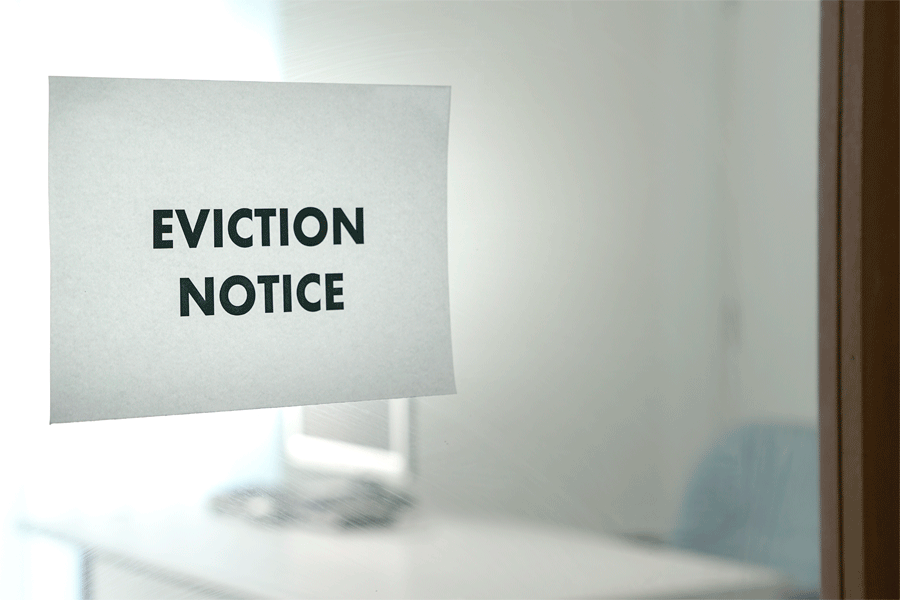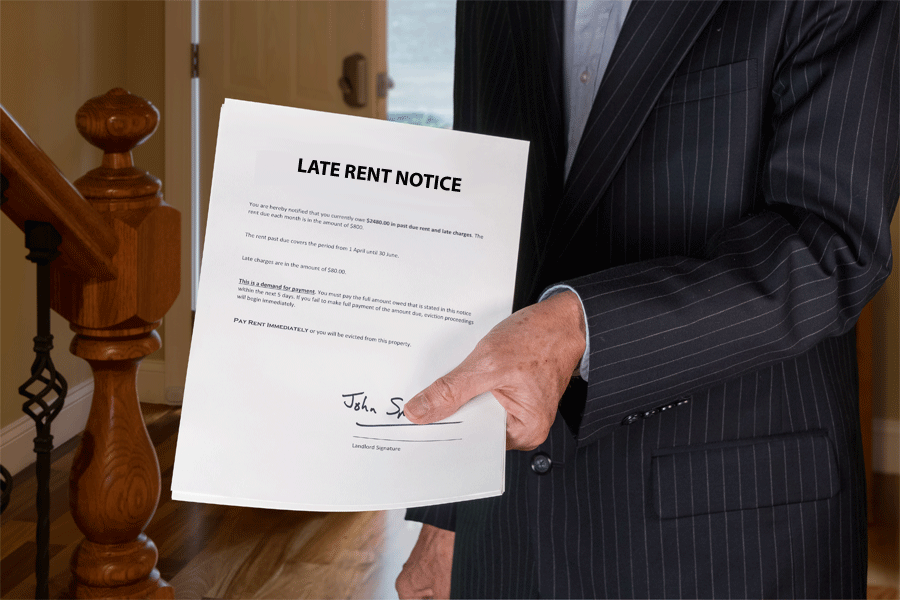An eviction notice form, also referred to as a “notice to quit,” is a letter sent to a tenant by a property owner informing them of a violation or termination of their rental lease agreement.
The letter is usually meant to inform the tenant that they must resolve certain problems, cease and desist from certain actions or vacate the property within a specified number of days.
Alternative names for an eviction notice form include:
- Landlord eviction notice
- Lease notice
- Warning notice
- Eviction letter
- Notice to vacate
- Warning letter
Free Eviction Notice Forms
Eviction Notice Forms (by Days)
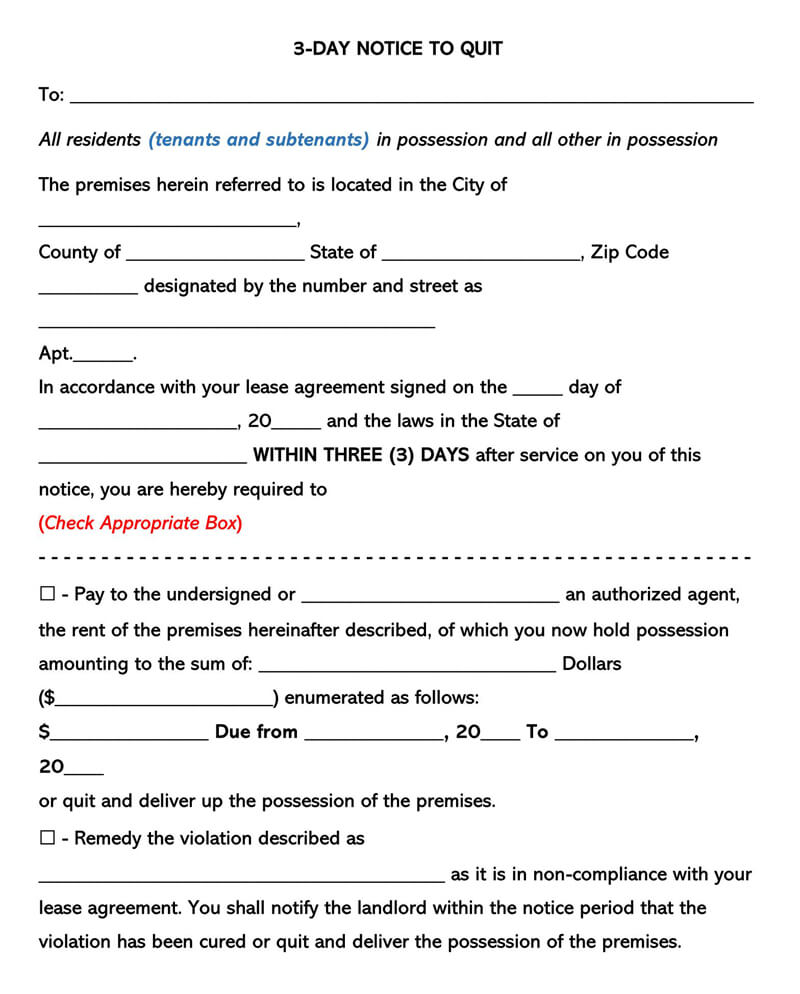
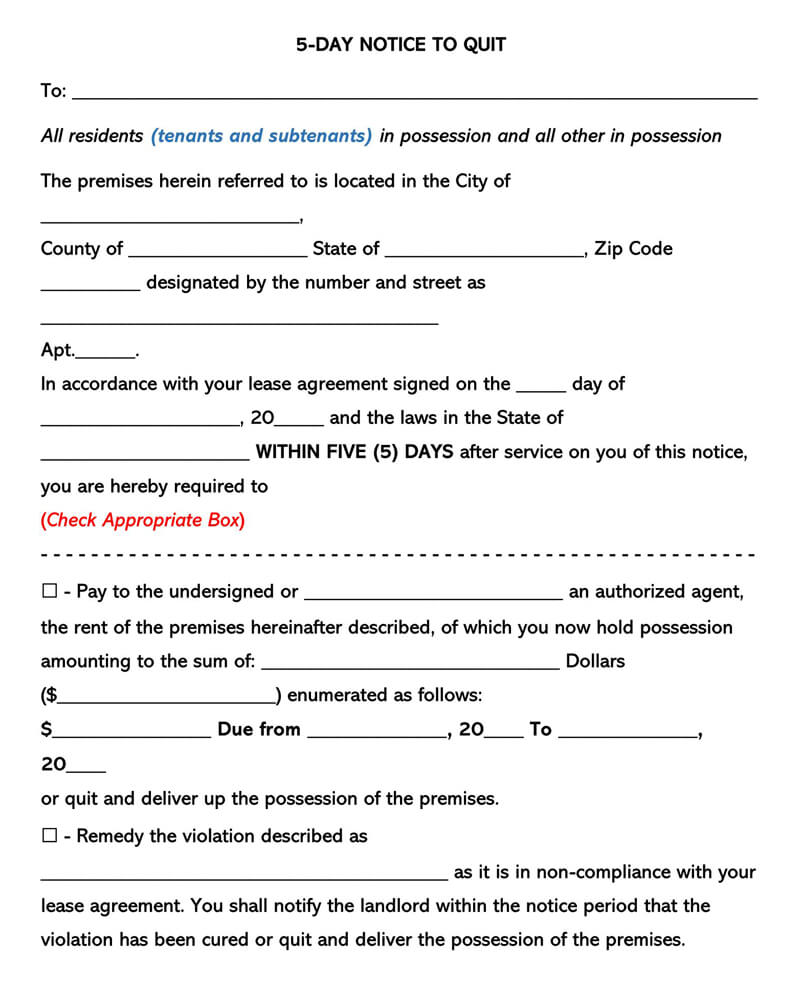
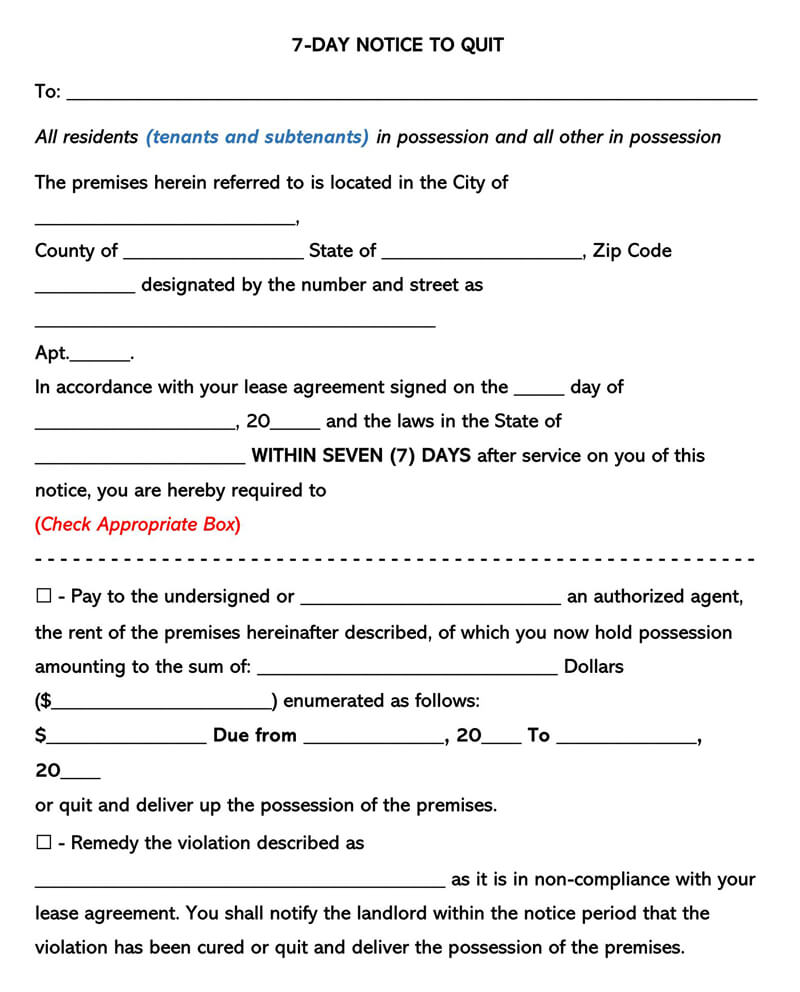
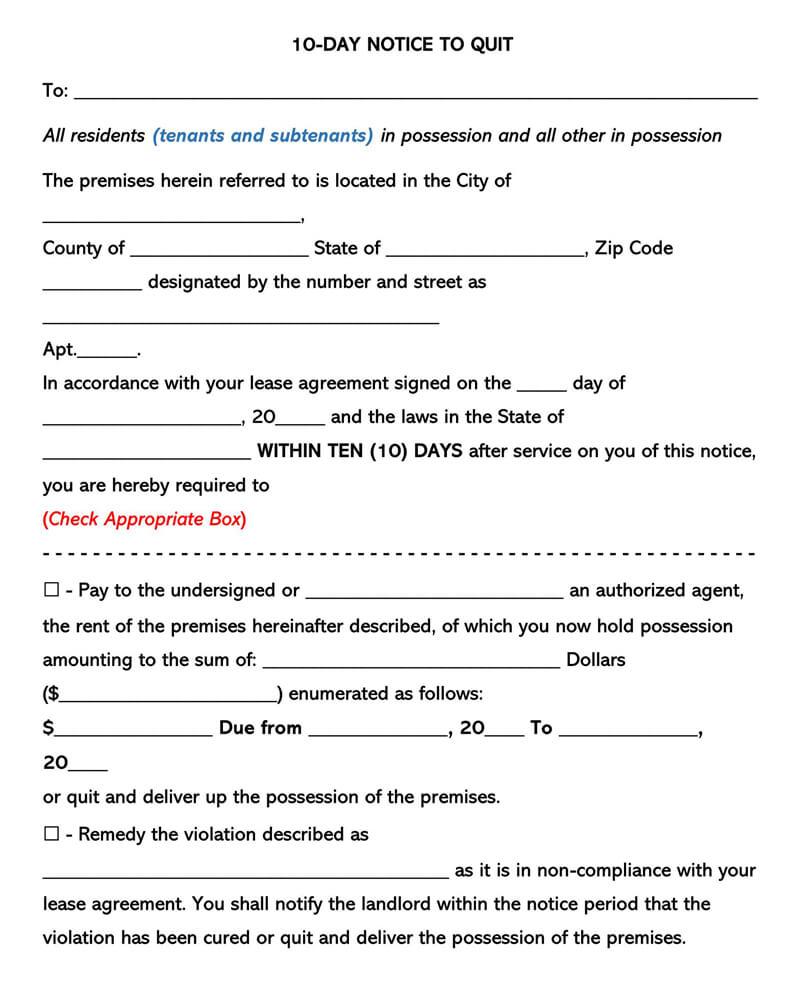
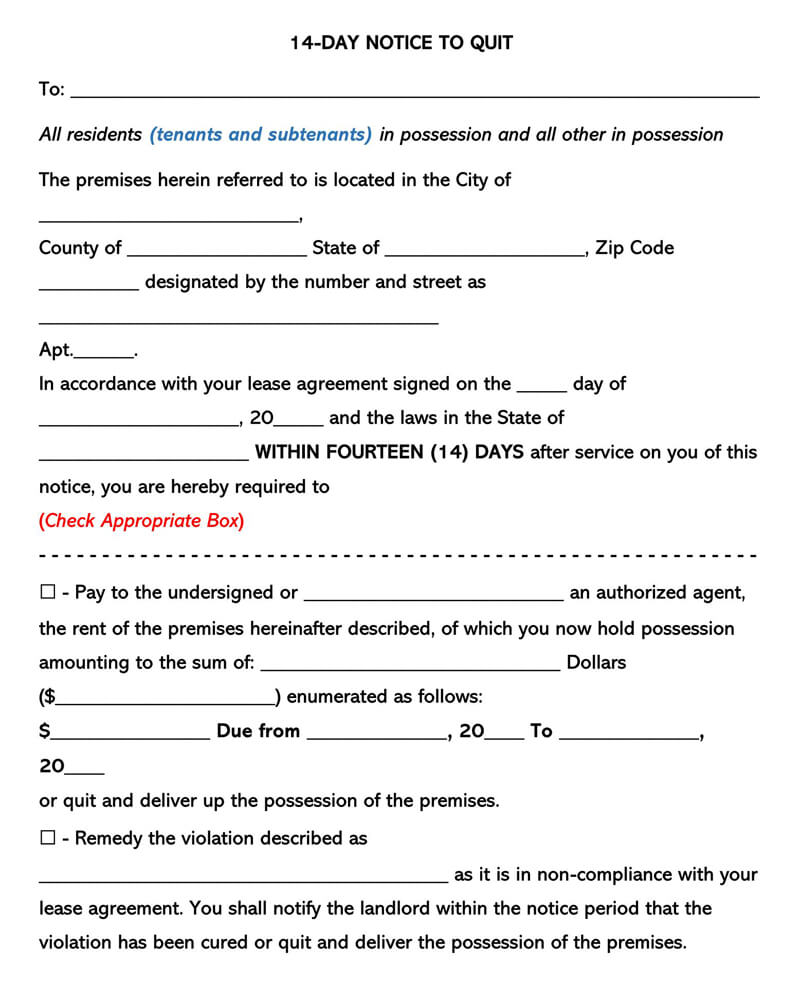
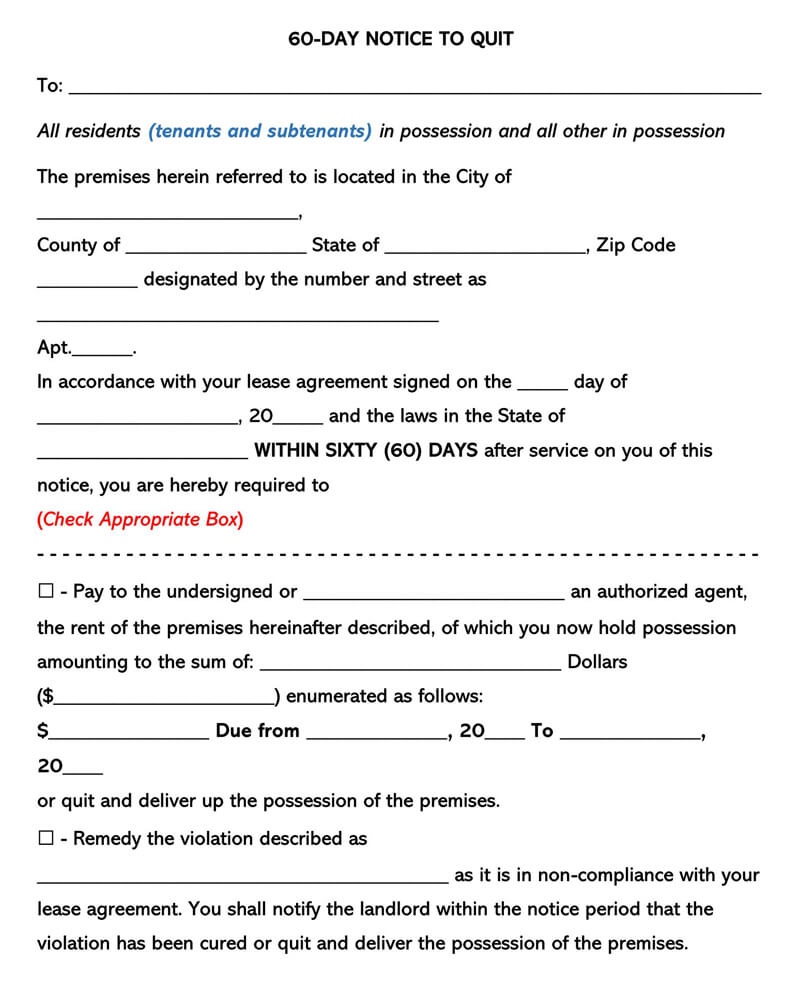
Eviction Notice Forms (by State)
Types of Eviction Notices
There are two major types of eviction notices, Curable and Incurable. A curable notice allows a tenant to remedy or cure the issue at hand, while an incurable notice requires that the tenant vacates the property on a date specified in the notice.
Besides these two main types of eviction notices, there are other types which include:
- 3-day notice: A 3-day notice of eviction is a form used to notify a tenant that they are in violation of the terms of their lease agreement and that they have up to 3 days to remedy their acts or move out.
- 5-day notice: A 5-day notice, just like a 3-day notice, is a document used to inform a tenant to remedy a violation of their lease agreement or leave the property. Once the 5-day notice has been issued, the tenant will have up to 5 days to remedy their acts or be evicted through the court system.
Other such types of forms include:
- 7-day notice
- 10-day notice
- 14-day notice
- 30–day notice
- 60–day notice
Notice to pay or vacate
A notice issued for failure to pay rent is a letter written by the landlord to the tenant, informing them of their failure to pay the rent due and that such payments should be made within a specified period to avoid further action against them.
The landlord is usually required to issue at least a 30-day vacation notice period to the tenant to enable them to pay any outstanding rent before moving out. However, depending on the situation, the notice issued can be as little as three days- just enough time to enable the tenant to pack, pay any dues, and move out.
In most states, tenants are usually required to pay their rent on time. More than a third of the states in the US require that a tenant be given a minimum 3-day notice by their landlord when they have failed to pay their rent, while a third of the states require that they be given a minimum of 5 days to remedy their acts. The remaining third requires that the tenant be given at least 7 days to remedy their actions before being evicted from the property.
Note
Three states, i.e., Indiana, North Carolina, and Pennsylvania, require that the tenant be given a 10-day notice for late rent, while other states, like Massachusetts, Vermont, and Tennessee, require that the tenant be given a 14-day notice before being evicted.
On the other hand, the District of Columbia requires that tenants be given a 30-day notice before being evicted.
Notice of lease violation
Also referred to as a Cure or Quit notice is a type of eviction notice issued by a landlord to a tenant who is in violation of the terms of their lease agreement. Examples of lease violations may include; having unauthorized tenants in the premises, damage to the property, making unauthorized renovations to the property, conducting unauthorized/illegal activities within the premises, etc.
When issued with this type of notice, the tenants are usually required to resolve the issue at hand or face eviction from the premises.
Depending on the type and severity of the violation, the tenant may be given only one chance to stop such violations or face eviction.
For instance, landlords in Maine are required to issue a 30-day notice for lease violations. They can, however, issue a 7-day notice to a tenant for material violations of their lease agreement.
In other states like Pennsylvania, landlords are required to issue a tenant who has lived on their property for more than one year with a 30-day eviction notice. If the tenant has lived for less than one year and has breached the terms of their lease agreement, they may be given a 15-day notice.
On the other hand, landlords in Montana only issue a 14-day notice to cure or quit for late rent payments and a 3-day notice if the tenant breaches a pet or guest policy.
Unconditional quit notice
An unconditional quit notice is a type of notice issued by a landlord to a tenant who has repeatedly violated their lease agreement. Such violations may include, but are not limited to:
- Failing to pay rent on multiple occasions
- Serious damage to the property
- Committing a Serious criminal activity on the property
- Failing to honor previous eviction notices issued
Note
An unconditional quit notice is usually issued when a tenant is in gross violation of the terms of the lease.
More than 2/3 of the states in the US require that tenants be issued with a 30- day eviction notice to terminate a monthly based or holdover tenancy. However, some states like Delaware and Georgia provide tenants with a 60-day notice when terminating month-to-month or holdover tenancy.
On the other hand, some states like Connecticut and Colorado require that the tenant be issued with a 3-day notice, while Wyoming does not require landlords to issue the tenant with any advanced notice.
Other states like New Jersey require the landlord to only evict a month-to-month tenant with a reason or cause.
Month-to-Month eviction/termination
The month-to-month eviction is invoked in the case of a month-to-month lease agreement. In this case, the landlord notifies the tenant to vacate the premises at the end of that month. Most of the time, the eviction is occasioned by the desire to increase the rental payments or the decision to repurpose the facility for another task.
Tip
It is always advised to check your state laws of eviction. You can read them here.
Components of an Eviction Notice
There are a number of things that have to be included in the Eviction Notice form. Before drafting, however, the landlord needs to keep in mind that this notice is admissible in court. Should the tenant fail to honor their demands and the issue escalate to court, the notice can be presented as evidence to show that such correspondences were established.
Therefore, it is important to include all the key elements required for the eviction notice, including:
Basic information
The eviction notice should have basic information such as the full name of the landlord and location of the property (unit number, street, city, and Zip Code), the full name of the tenant is given the notice- should be the same as included in the lease agreement and the date in which the notice is issued.
Reason for eviction
When drafting an eviction notice, it is important to include the reason for writing the letter. Do not assume that the tenant already knows why they are being evicted. Make clear the reason for the eviction notice to avoid instances where the tenant may claim unfair or discriminatory evictions. If the reasons for eviction are more than one, make sure to list them in all the eviction letters sent to the tenant.
Some of the common reasons for evictions include:
- Intentional substantial abuse of damage to the premises
- Noise violations
- Non-payment of rent
- Taking part in or performing illegal activities in or within the premises
- Violence towards other tenants
Ensure that the reason provided in the eviction notice is legitimate and non-discriminatory. For example, one should not be evicted because of their national origin, race, color, religion, sex, familial status, disability, marital status, etc.
When and where the eviction is occurring
Indicate in the notice when and where the eviction is occurring. Make sure to provide an exact date on which the tenant must vacate or a timeline for when they must remedy their mistakes and failure to which further action will be taken against them. Also, make sure to mention the name of the building, house number, and any other important identifying information such as the building’s registration number and street address.
Solution
The notice of eviction should offer a solution based on the type and severity of the violation of the lease agreement. For instance, if the tenant has failed to pay their rent, the notice can indicate a time allowance to remedy their violation failure to vacate the premises. Also, if the tenant has done adverse damages to the property, the landlord may offer them a solution to make repairs to the premises, failure to which matters may escalate to small claims court.
Certificate of service
Most states require that all eviction notices be delivered to the tenant by a constable, sheriff, licence process server, or agent of an attorney licensed in the same state. Make sure to send and keep a certificate of the eviction notice, which is usually issued by the relevant authorities after the notice has been issued.
Notice date and deadline
The eviction notice form should also include the notice date and the deadline for the eviction. The notice date is the date on which the eviction notice was issued, and the deadline is the date on which the tenant must remedy their violations before facing eviction.
Contact information
In the eviction notice form, make sure to include your contact information, i.e., your phone number, email address, and physical address, for the tenant to contact you should they have any issues, questions, or queries regarding the eviction. Also, include your name/property name and signature at the bottom.
How to Evict a Tenant?
We now get to the core of the matter. Here, we shall examine the steps involved in kicking out a tenant from your premises. We outline and discuss them fully here below:
Step I: Identify the right reason
Start off by identifying the right reason to kick out the tenant. Simply put: why exactly how you have seen it necessary to kick the tenant out? Is it because he engaged in illegal activity? Could it be that he has faltered in remitting the rental dues? Be sure that the reason you identify is well-anchored in law.
Step II: Reason out with the tenant
Before using the legal route, it is important that you reason out with the tenant. Have some time to talk to him about the issue. Try and find out why he is guilty of that violation and what he plans to do to remedy the situation if given time.
Step III: Notify the tenant of the impending eviction
In case the tenant is unable or unwilling to mind his ways, you have to take a step further by notifying him of the impending eviction. Give him formal notice of eviction and note how he responds to it. Take care, though, that you do not threaten him as that may land you in hot soup with the law.
Step IV: File the eviction notice with the court of law
Many states demand that a court of law sanction any eviction before the same might take effect. If the tenant is still unwilling to mend his ways, you will have no other choice but to head straight to a court of law to argue it there. Attend all sessions faithfully and explain your side of the story there.
Step V: Evict the tenant
Finally, evict the tenant. This will require that you serve him with the court-sanctioned eviction notice. Thereafter, you will have to give him some time to ‘put his house in order.’ You will have to bring in law enforcement officers to kick the tenant out if the tenant will not have vacated the premises upon the expiry of the notice. Do not forget to collect your past dues too!
CAUTION
- Never take matters into your own hands by forcefully evicting the tenant without the authorization of the courts.
- Familiarize yourself with the laws that govern such evictions in the state where you reside.
- Do not harass your tenant with too many phone calls, text messages, or verbal notices, as these may be erroneously misconstrued to be harassment.
- Always work with a lawyer throughout the entire process.
- If, after the expiration of the ultimatum, the tenant will not have vacated the premises, you may have to bring in the sheriff to get the tenant out alongside his possessions.
Frequently Asked Questions
There is no standard length of time that the eviction takes. The precise amount varies depending on the size of the facility, the nature of the lease, the kind of violation, and the security threats that are posed by the tenant in question. Moreover, different state laws delineate different timelines for evictions.
An unlawful detainer is a legal way of kicking out a tenant from your premises. This entails the invocation of the court of law to authorize and sanction such an intent. An eviction, on the other hand, is the use of force to kick out a tenant without invoking the intervention of a court of law. Here, the landlord literally takes matters into his own hands.
It is legally required to send an eviction notice to inform a tenant that they are in violation of their lease agreement and that they should take the necessary steps to remedy such violations. It is legally designed to protect both the landlord and tenant’s rights.
The property address includes the property’s full address, i.e., unit number, street, city, and Zip Code.
It is important to send an eviction notice to inform the tenant of their violations. Failure to send this notice may lead to the tenant not moving out or continuing with their violations. Informing the tenant of their violations may make them desist from such acts or remedy their breach to avoid further actions that may be costly to them.

